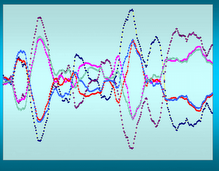What I want to discuss today is a method for using the pivot point as a means of determining overall trend of the market and as a timing method. Shown below is the last 170 days or so of the QQQQ ETF annotated to show a variety of features. The fact that the blue line is the pivot point and the red line is the average of the pivot point shouldn’t bother you in the least.

You can see clearly that you can use the pivot point and the exponential moving average as a means to determine long term trend as well as using it for determining buying or selling points.
If you want to do major buy or sell events there are two things you need to watch for – first that the pivot point crosses the 20-period exponential moving average and second – that the 20-period EMA confirms by turning in the direction as the pivot point. Once the turn is made it stays in effect for quite some time. Sometimes areas of congestion can be related to earlier activity in the stock. These are shown by drawing lines from one side to the other. The reason for this is that battles have already been won or lost in these areas and wherever there is a lot of congestion there is generally a lot of volume. That means that sometimes people have been trapped in the trade for a long time and now just want to get out. Consequently a lot more buying or selling pressure is put on the market. The short side players can see this too and they begin to take advantage of areas of perceived weakness. Once the area is broken through however the shortists help in its ascension by panic covering.
One area is annotated as the primary support/resistance. That is because this is where the descent was made some months ago and it represents a near term high of the market. However once the QQQQ broke out of the area of primary support/resistance it began going into new territory for this year. In the last 20 days or so it has begun once more to congest and the 20-period EMA seemed to be getting ready to roll over again. The following diagram is a cut-out of the last 20 days.

Instead a bull pennant formed and it is possible that the last two days signify a breakout from the pennant. The 20-period EMA seems to have resumed its upward trend. I think that if you are short the Q’s at this time you might consider covering until the actual trend is revealed.
Why, you ask, use the pivot point? Simple enough I reply – it shows “bottoming” more clearly than does the raw close by itself.
Look at the area of the long term chart marked false turn. Then look at the area marked real turn. Market bottoms are most often characterized by higher highs and higher lows, but they are also periods of indecision. Note how the points cluster together in the real turn and how they remained fairly constantly spaced in the false turn. You can see this again in the top right corner. That’s why I say it is of the highest probability that the Q’s are going higher.
Remember nothing is certain in the stock market and any event good or bad can cause the bulls to scatter and the bears to appear.

1 comment:
yeezy
air jordan
yeezy boost 350
golden goose superstar
calvin klein outlet
jordan shoes
kd12
kyrie 5 spongebob
supreme clothing
kd 12
Post a Comment